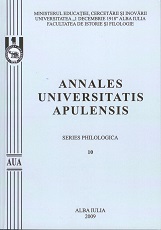Vasele amforoidale medievale timpurii din vestul şi nord-vestul României
Early mediaeval amphora type vessels on Romania’s western and north-western area
Author(s): Dan Bacuet-CrisanSubject(s): Archaeology
Published by: Editura Mega Print SRL
Keywords: discoveries; settlements; fortress; residence; classification
Summary/Abstract: The boundaries of the area in discussion are formed by the Ţibleş-Gutâi-Oaş mountain chain in North, Romania’s western frontier, on the South Mureş River and on the East, the Eastern Carpathians (Pl. I/1). This vessel type was destined exclusively for liquid transportation and keeping, that’s why some of them have handles, but some of them, do not have it at all. We also mention the fact, that in the specialty bibliography these pots are mentioned under several names, like amphora, jug and in some cases flasks. Because of the fact that in the majority of cases the archeological material is very fragmentary, we can not analyze it to conclude if there were handles, or not, so we just call this kind of pottery amphora type vessels. During this article we would like to analyze this type of pottery dating in the early medieval period, found in the north-western area of Romania, and to propose a typological and chronological classification as well. To accomplish such an objective, it’s a quite hard work, because in spite the fact that this kind of pottery is part of the 7th-13th century vessel it is rarely found. We will study archaeological discoveries published in special literature, using these information (as they are) given by the authors of the researches and/or discoveries. What concerns the north-western part of Romania, we present nine sites with amphora type vessel discoveries, sites spread on the territory of six localities (Pl. I/2). By the characteristics of amphora type vessels discovered (dimensions, form of the pot lip, opening and neck), we have identified the existence of 4 types (each of them, having it’s own 2 variants). The classification proposed by us, concerning this type of pottery identified on the north-western area of Romania, can be dated as we present it below: a. TYPE IA and IB last decades of the 7th century – first half of the 8th century; b. TYPE IIA 8th century – beginning of 9th century; c. TYPE IIB belongs to 9th – 12th centuries; d. TYPES IIIA and IIIB 11th- -13th centuries; e. TYPES IVA and IVB are dated in the 10th century, possible further on to the 11th century. In the already mentioned area of this country we have registered 9 archaeological sites with amphora type pottery discoveries, for what, we now propose a typological classification. Some of them were discovered in the context of early medieval settlements (Nuşfalău “Ţigoiul lui Benedek”, Bobota “Pe vale”, Biharea “Grădina SA-Baraj”, Biharea “Lutărie 1”, Cefa “La Pădure”), others in an early medieval fortress (Biharea “Cetatea de pământ-incintă. Zona de sud-vest” (“Măr”), Biharea “Zona cetăţii de pământ”), towards early medieval residence (Sânnicolau de Beiuş “Dealul bisericii”) and one in a village’s field without precise location (Sântandrei). Of course we do not exclude the possibility of other discoveries of this kind, yet not published, the real number of these discoveries being much larger than it is in this moment.
Journal: Annales Universitatis Apulensis Series Historica
- Issue Year: 13/2009
- Issue No: 1
- Page Range: 69-87
- Page Count: 19
- Language: Romanian
- Content File-PDF

